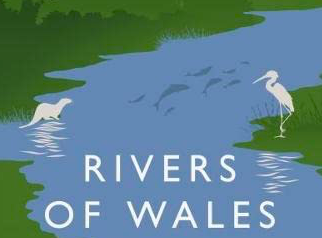Adam Somerset reviews Rivers of Wales by Jim Perrin, a dive into the geography, mythology, social history and natural history which exist as a result of the flowing waters.
Rivers of Wales is a complement to The Hills of Wales (reviewed in Wales Arts Review in 2016). Hills and rivers exist in symbiosis. The valleys make the uplands and the uplands make the valleys. The upland terrain works as a giant sponge, soaking up the rain. In Perrin’s metaphor the high land acts “as midwife to many rivers. Mynydd Hiraethog, Y Migneint, Waunygriafolen.. .all these have their river-children.”
The rivers of Wales run to the hundreds. This book is made of four long chapters and an “Envoi” at the Dwyfor. Teifi and Wye receive 80 pages apiece. Cynfal, Dwyryd and Glaslyn are grouped as a trio of similar length. Dyfi and Dysynni as a pair cover a shorter 17 pages. The first words, after an acute and crisp introduction by Rob Mimpriss, are “Loops, Meanders and Thoreauvian Digressions.” The phase foretells what is to come; a river is a good metaphor for the writing – it may twist and turn unexpectedly. The ox-bow turns of the Tywi are one of the joys to be seen from the ramparts of Dryslwyn Castle. A narrowing of the banks enforces a speed of current and alternates with wider surfaces and their gentler flow. This variation is reflected in the writing which criss-crosses from polemic to meditativeness to memory.
Jim Perrin says of landscape that it “gives you something to question, pictures to create in your mind, purposes to unravel, the jigsaw of history to piece together from the disparate elements of fact, feature, literature, place, imagination and mood.” The spell of the rivers goes beyond the literal: “Rivers are texts by which are expressed the land’s folklore, its mythology, the culture of the people, the character of each region, even the harm done to our landscapes.” The book reveals a lifetime of reading. The names of his forerunners tumble out: Ronald Blythe, Arthur George Bradley, George Borrow, Tom Fort, Bernd Heinrich, Peter Matthesen, Sorley Maclean, Cameron McNeish, George Peterken, George Schaller, Nan Shepherd. Footnotes are regular and warmly digressive. A half-page note traces the Unitarianism of mid-Ceredigion back through Socinianism, Arianism to Arminianism. Religious schism is just one of the currents of history that haunt. The monks of Bangor-Is-Coed were massacred at the command of Canterbury, their offence the heresy of Pelagianism.
The Rivers of Wales is also elliptically a biography. A sole phrase speaks of “my own Manchester inner-city slum kid upbringing.” But the outdoors appeared: “In my mis-spent youth I gaffed salmon out of Afon Lledr”, he recalls, “and tickled sea trout from Afon Dwyfor.” On a first trip to Wales he made his way from the Dee to Bala to Trawsfynydd then north. Later he recalls supervising and assessing Duke of Edinburgh Award schemes. He was outdoor pursuits instructor at the City of Oxford Outdoor Pursuits Centre at Glasbury-on -Wye. Later he is making a film for the BBC in County Mayo and sleeping out under Dafydd ap Gwilym’s yew-tree. “In the 1970s”, he says “lived in Cwm Pennant.”
His eye is keenly trained for avian companions. Observations are many of curlew, dipper, drake teal, egret, golden plover, goosander, kingfisher, oystercatcher, peregrine, ring-ouzel, snipe, black-headed gull, widgeon, woodcock. He recalls Bill Condry writing of the cull of thousands of oystercatchers at Burry Inlet. Places for refreshment, conviviality and human companionship are just as regular. The Maesllwch Arms, the Harp, the Radnorshire Arms, the Boat Inn, the Anglesey Arms, the Netpool Inn, the Bryncir Arms, the Pengwern Arms, the Royal Goat, the Red Lion at Mallwyd, the Black Lion at Derwenlas: they all get their commendation.
But the valleys and fields that Perrin walks are no Eden. On 18th July, the First Minister led a summit at the Royal Welsh Show to reduce the pollution in the rivers of Wales. In mid-July, an amber alert was issued for the Wye due to more algal bloom, the result of phosphorus excess. From childhood Perrin remembers a history teacher who referred to the Rivers Irwell, Medlock and Irk as the Inkwell, the Mudlark and the Murk. He observes the liquid manure that flows into the Wye where it is joined the Llynfi. In the lower Teifi he sees that the water at Cilgerran “swirls brown and uninviting with the price of depleted salmon, sewin and trout.” The book comes with the quality finish that is the Gomer hallmark (the designer is Siôn Ilar – Rob Mimpriss is editor). A late footnote gives a hint that a second volume may be due on Alun, Arrow, Cleddau, Dyfi, Rheidol, Serw and Usk. It is to be welcomed to add to the rich and distinctive voice of Perrin.
Rivers of Wales by Jim Perrin is available via Gwasg Carreg Gwalch.











